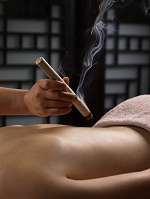The search for the mythical Fountain of Youth continues to appeal and intrigue us. Legends about the healing powers of these waters abound in cultures throughout the world. The legendary spring reputedly restored the youth of anyone who drank of its waters. The Fountain has been used as a metaphor for anything that improves longevity.
If you are intrigued by the legend, moxa could be just one of those legendary Fountain of Youth elixirs. The gentle, warming, nurturing, invigorating experience of moxa appeals to the consumer by revitalizing the mind and body, improving quality of life and strengthening the immune system.
In Chinese Medicine, the leaf of Artemisia Vulgaris is stated to have bitter and acrid property. The acrid property allows the plant to lift and revitalize energy while the bitter helps eliminate heaviness and edema in the body.
Moxa is a fire therapy. The wool is used in treatments by placing the wool on key points and burning the moxa.
There are a variety of different techniques which can be adopted when using moxa. Cones can be used. Cones are either very small beads applied directly to the skin or small cones placed on a substance such as ginger or salt. The cones are then lit and burned. They burn slowly and lightly. A usual number of cones burned are between eight and 24. The cones are allowed to burn down and removed quickly to avoid burning the skin.
Another moxa method is the moxa stick which is a thick, tightly rolled stick of moxa wool approximately as thick as your thumb. One end will be lit and allowed to burn. The stick will be placed about an inch away from the body and moved over the body.
Moxa is pure yang in nature having the ability to restore the primary qi of the body. In Chinese Medicine, qi is the essential substance of the human body that maintains vital activities. Primary qi stimulates and promotes the functional activities of all the organs of the body. As the primary qi declines, a person can experience a variety of disorders in the body including: sensations of cold, fatigue, poor immune system, pain, or chronic disease.
In Chinese Medicine, therapies are used to restore balance and harmony. Moxa or mugwort strongly supports the yang and aids in restoring primary qi. Thus, it is very beneficial in expelling cold from the body, reducing fatigue and pain, improving chronic situations, strengthening immune systems, restoring circulation, repairing body tissues and structures and many others. Yet, its nature is very gentle making it wonderfully useful in chronic, difficult to move situations or persons with weakened constitutions from age or disease.
If the Fountain of Youth is about finding an elixir which can improve aging, quality of life, and help with controlling and preventing chronic illness, moxa is a small part of Chinese Medicine which fits the bill. For those who have been to an experienced practitioner in Chinese Medicine and had the benefit of moxa, first hand, the dramatic and relaxing effects of moxa have no comparison.


